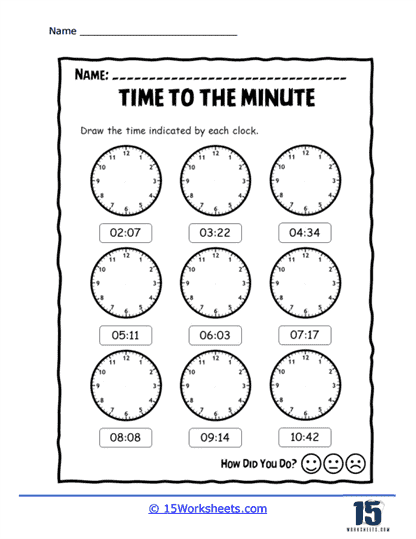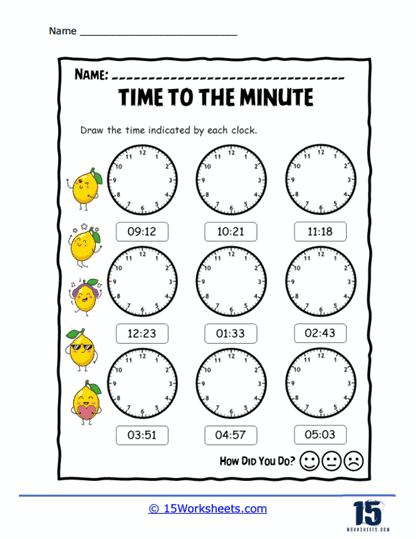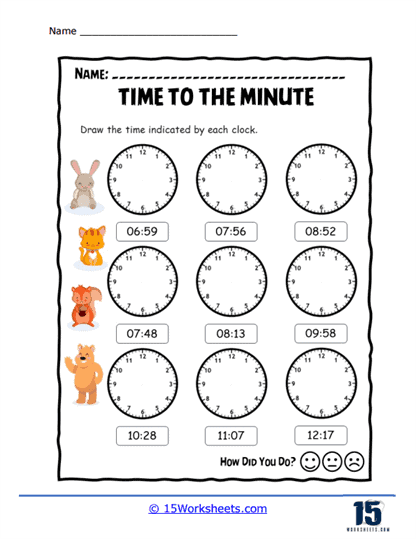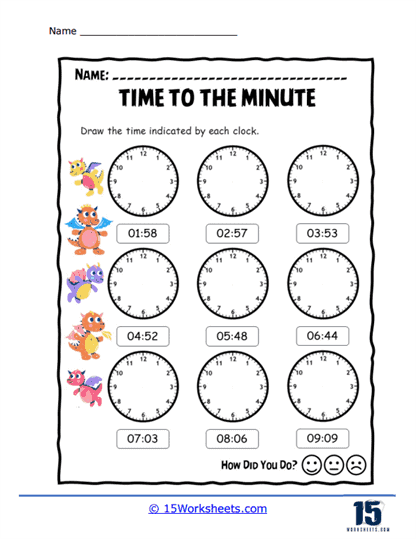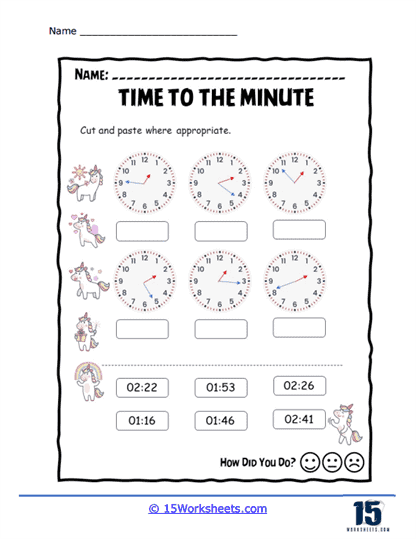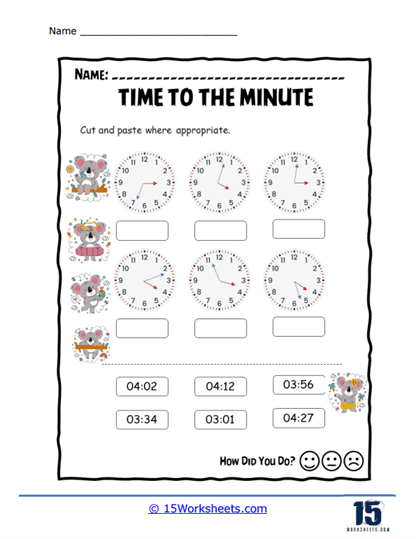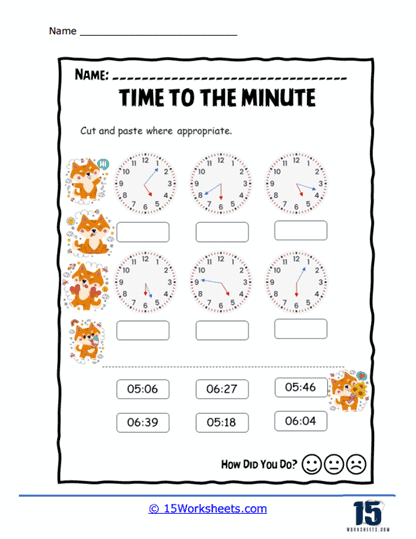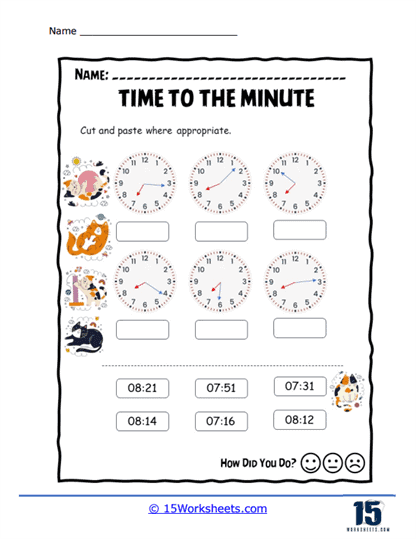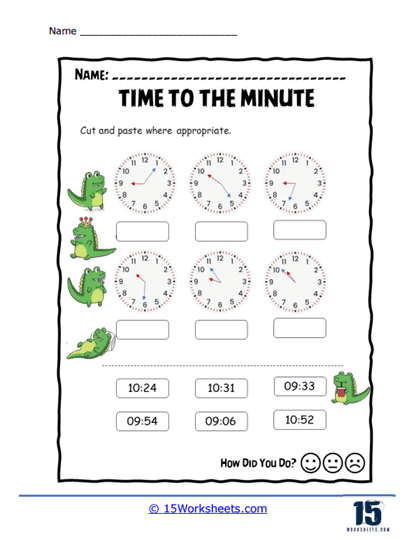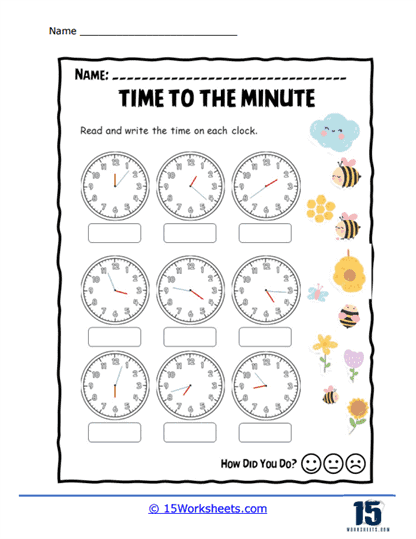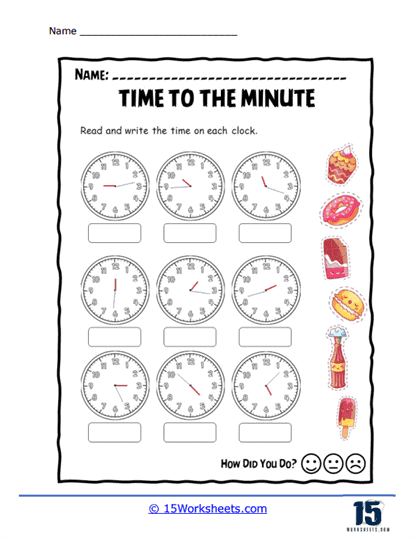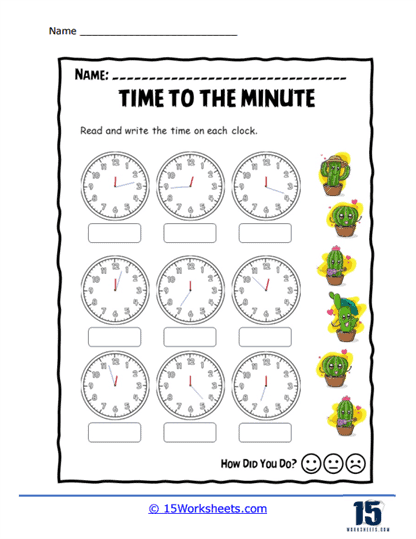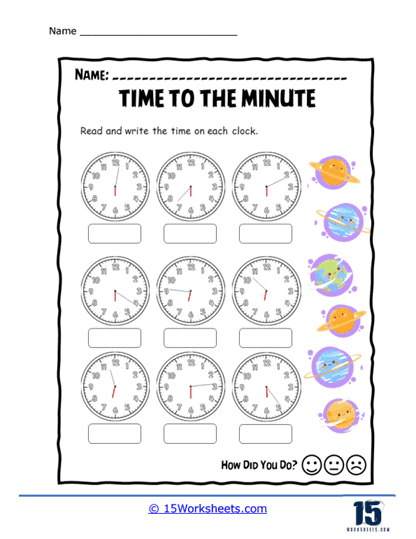Time to the Minute Worksheets
About These 15 Worksheets
These worksheets will help students learn how to read, interpret, and record time accurately to the minute on both analog and digital clocks. These worksheets provide a variety of exercises that enable students to practice this fundamental skill, which is crucial for everyday life and numerous real-world applications. By engaging in these exercises, students develop a deeper understanding of time-telling and enhance their mathematical proficiency.
The worksheets typically feature a range of clock-reading tasks, including reading times from analog clocks, drawing hands on clock faces to represent specific times, matching digital times to analog clocks, and solving time-related word problems. Often, these worksheets incorporate themes and illustrations to make the activities more engaging and enjoyable for young learners.
Mathematical Skills Explored
These worksheets encompass a comprehensive range of mathematical skills that are crucial for students to master precise time-telling. These worksheets begin by reinforcing basic clock-reading skills, ensuring that students can accurately interpret the positions of both the hour and minute hands on an analog clock. This foundational skill is essential as students need to understand that each number on the clock face represents five-minute intervals and that the minute hand moves in these increments around the clock.
A significant mathematical skill developed through these worksheets is the ability to count by fives and ones. Students must count by fives to determine the minutes when the minute hand points to the larger numbers on the clock (e.g., 1 = 5 minutes, 2 = 10 minutes), and they need to switch to counting by ones for the individual minute markers between the larger numbers. This dual counting method reinforces their understanding of skip counting and basic arithmetic, which are fundamental skills in mathematics.
Another key skill examined in these worksheets is the concept of addition and subtraction within the context of time. Students learn to calculate the total minutes past the hour by adding the minutes indicated by the minute hand to the hour shown by the hour hand. Conversely, they might need to subtract to find out how many minutes are left until the next hour. These exercises enhance their ability to perform addition and subtraction operations and apply these skills practically.
Understanding fractions is also an integral part of telling time to the minute. The clock face can be divided into quarters (15 minutes), halves (30 minutes), and other fractions, and students must recognize these divisions. For instance, knowing that a quarter past an hour means 15 minutes past or that half-past means 30 minutes past the hour helps students link their knowledge of fractions to real-world applications.
The Benefits Of These Worksheets
Learning how to tell time to the minutes offers numerous benefits that extend far beyond the basic ability to read a clock. One of the primary advantages is the enhancement of mathematical skills. Telling time to the minute involves understanding and applying concepts such as counting by fives and ones, addition and subtraction, and recognizing fractions. These exercises reinforce fundamental arithmetic skills and help students develop a solid mathematical foundation. Additionally, working with minute intervals introduces students to more complex calculations, which can improve their overall numeracy and problem-solving abilities.
Another significant benefit is the development of precision and attention to detail. Reading time to the minute requires students to pay close attention to the exact positions of the hour and minute hands on an analog clock. This precision translates to other areas of learning and daily life, encouraging meticulousness and careful observation. Being able to differentiate between, for example, 3:25 and 3:26 fosters a sense of accuracy and helps students appreciate the importance of small details.
Mastering the skill of telling time to the minute enhances time management and organizational abilities. Students learn to plan their activities more effectively by understanding exactly how much time has passed or how much time is left until a particular event. This skill is crucial for managing schedules, meeting deadlines, and balancing various tasks throughout the day. Improved time management skills lead to greater efficiency and productivity, both in academic settings and in personal life.
Real World Application Of This Skill
In the real world, the ability to tell time to the minute is indispensable in numerous everyday scenarios. For instance, in educational settings, students must adhere to specific schedules for classes, exams, and extracurricular activities. Knowing the exact time helps them transition smoothly between different parts of their day, ensuring punctuality and reducing stress. Teachers also rely on precise time-telling to manage classroom activities, allocate time for lessons, and maintain a structured learning environment.
In professional contexts, telling time to the minute is vital for productivity and coordination. Employees often need to schedule meetings, manage project timelines, and adhere to deadlines that require exact timing. For example, a meeting might be scheduled to start at 9:15 AM and end at 10:00 AM, and knowing how to read this time accurately ensures punctual attendance and effective time management during the meeting. Professionals in fields such as healthcare, transportation, and hospitality also depend on precise time-telling to coordinate services, manage appointments, and maintain smooth operations.
In personal life, telling time to the minute is essential for managing daily routines and activities. Whether it is catching a bus that leaves at 7:43 AM, cooking a meal that requires precise timing, or coordinating family schedules, knowing the exact time is crucial. Parents use this skill to help children develop good habits, such as getting ready for school on time or going to bed at a consistent hour. Accurate time-telling also plays a significant role in social interactions, such as meeting friends for coffee or attending events where punctuality is expected.

